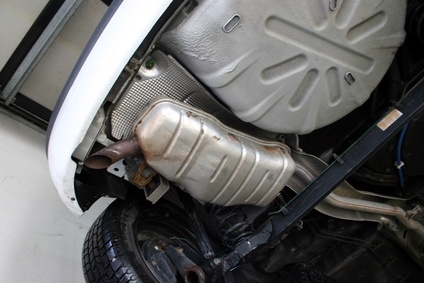
Toyota trucks have been available in the American market since 1964. Offered with engine sizes ranging from small four-cylinder engines to large V8's, according to the U.S. Department of Energy. The four-cylinder engines generally achieve better gas mileage than the larger engine sizes. A Toyota truck's engine size, engine type, transmission and axle gearing, exhaust system and exterior styling all contribute to the fuel economy ratings of these vehicles. Actual fuel economy depends on driving style, weather, current state of maintenance and aftermarket additions (both on the drive line or the exterior of the vehicle).
Alter driving habits to increase fuel economy. The U.S. Department of Energy states that aggressive driving can reduce fuel economy by 5 to 33 percent. Accelerate moderately, stay within posted speed limits, reduce highway speeds to 55 MPH and coast to stops (rather than maintaining speed with gasoline then breaking at the last moment).
Remove excess weight from the truck. Items not needed for commuting (e.g., rear seats, toolboxes or sand bags in the bed of the truck) should be removed and replaced only when needed. For every 100 pounds of weight you remove, a Toyota truck's mileage can improve by as much as 2 percent.
Avoid using the four wheel system unless necessary. When gears to all wheels are engaged, fuel economy decreases.
Turn off the truck if you expect to be idling for more than 30 to 60 seconds. Fuel consumed at idle significantly degrades overall mileage by as much as .1 percent for every minute you idle.
Drive outside the ruts if you are driving on wet surfaces. Water tension on the tires of the truck will decrease mileage by as much as 2 percent.
Maintain tire pressure at the maximum cold pressure. Low pressures in even a single tire can reduce mileage by as much as 15 percent. Keeping tires inflated to the maximum cold pressure reduces total drag on the vehicle and will also increase the life of the tire tread.
Exchange the standard fluids in the vehicle with fully synthetic fluids. Engine oil, transmission fluid, gear box and differential fluid should be replaced with equivalent fully synthetic fluids to reduce friction on the drive train. The Toyota truck's drive train will have to work less to accelerate and maintain speeds and will coast longer with synthetic fluids, resulting in higher mileage.
Replace the spark plugs, spark plug wires, fuel injectors and the cap and rotor (if not electronically controlled). Spark plug terminals will degrade with us,e creating a larger gap between the terminal and post, reducing the efficiency of the spark when igniting the fuel. Fuel injectors may be cleaned with fuel system additives, or replaced if worn for additional mileage gains. Cap and rotor and spark plug wire replacement (according to Toyota's schedule recommendations) may improve the performance of your engine, restore lost power and increase fuel economy.
Remove exterior modifications to reduce air drag. Rain deflectors, bug guards, ground effects and step side rails all create air resistance that my decrease mileage.
Exchange the stock exhaust system with a performance exhaust. Performance exhaust systems designed for your truck will increase exhaust flow while maintaining proper back-pressure. The exhaust system improvements increase the efficiency of your engine, resulting in higher mileage per gallon of gasoline combusted.
Insulate the truck engine's exhaust manifold or headers. High-temperature exhaust wraps around the exhaust components insulate and prevent the transfer of heat to the air intake system (manifold or engine compartment). The cooler air is, the more dense it is, allowing more oxygen to be combusted with the fuel. Increased energy output results in less fuel to provide power and increases mileage.
Tune the engine and transmission. Professional tuners access your vehicle's on-board computer through the OBDII port (located under the driver's side dash, if available) with software programs to adjust performance settings. Hand-held performance tuners allow you to load pre-programmed tunes for many Toyota trucks without the need of a professional tuner technician.